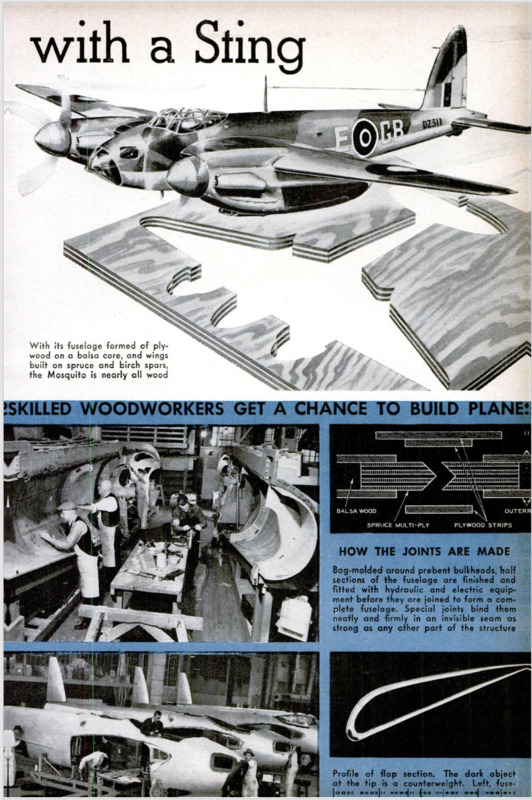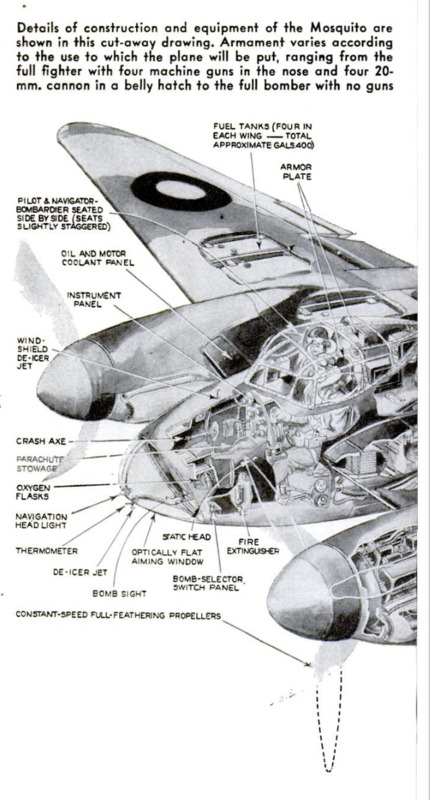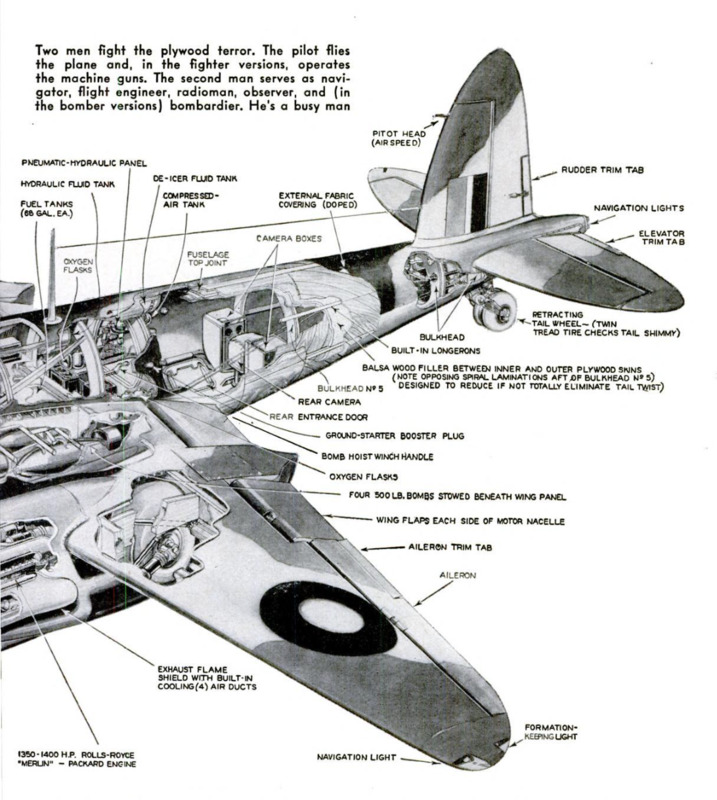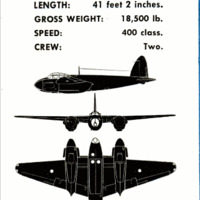-
Title (Dublin Core)
-
The Strength of Mosquito
-
Article Title and/or Image Caption (Dublin Core)
-
Flying Plywood with a Sting
-
extracted text (Extract Text)
-
THE massive aerial assault against Berlin
did not come without warning. Many
months before it was launched, the Nazi
capital had a grim hint of what was to come
—a hint delivered by the unpredictable,’
whiplash attacks of the light British Mos-
quito bomber, the unconventional plywood
airplane which British enthusiasts have
flatly called “the world’s fastest aircraft.”
In the days when the Allies were patiently
building up their heavy-bomber power, Mos-
quitoes first streaked over the heart of the
Reich to carry out surprise raids. Then, as
the time drew near when major attacks on
Berlin could be mounted, they harassed
Central Germany with systematic attacks,
keeping the antiaircraft and fighter-plane
defenses in a state of continuous, exhausting
alert and bruising the morale of the indus-
trial city-dwellers,
‘When Allied heavy bombers struck their
first blow, paralyzing Berlin in one crowded
hour with 2,000 tons of bombs, Mosquitoes
raced back next day to follow up their mis-
sion with more destruction and disorganiza-
tion. However, the acute warning of the
Mosquitoes’ stinging powers came more
than a year ago, when bombers of this type
raided Berlin during the pompous celebra-
tion of the tenth anniversary of the Nazis’
rise to power. This audacious attack and
the many that followed showed the Ger-
mans the plane's unpleasant habits. They
learned that it was a sleek, twin-engined
attack bomber, which usually popped in
from nowhere at very low altitude, dropped
full-ton loads of delayed-action bombs on
rail junctions, tool factories, and other key
targets, then disappeared with ease.
There is more to this new all-wood air-
plane than meets the casual glance. The
offhand observation would be that Britain
was trying to bolster production with a type
of airplane that would spare critical ma-
terials, tap hitherto unused labor supplies,
and enable parts of the Empire which had
wood and craftsmen available, but no air-
craft metals, to take part in the airplane-
building program. In essence all of these
facts are true, but they are only supporting
reasons for building the Mosquito. The De
Havilland 98, as the ship is officially desig-
nated, embodies the most advanced method
of nonmetal airframe construction. Its
wooden frame has proved to be equal to
metal in strength-for-weight, superior in
surface rigidity (important in high-speed
operation), and much easier to repair and
maintain than metal frames. Furthermore,
this type of airframe is cheaper to build and
modify, since it requires only woodworking
tools, which cost less than tools for metal.
For over two decades, advocates of wood-
en airplane structures have pointed out that
there is nothing wrong with wood as an air-
plane material. Any basic disadvantage as-
cribed to wood construction stemmed from
the adhesives commonly used—casein and
blood-albumen glues, which are subject to
deterioration from moisture, fungus, and
bacterial action. The advent of synthetic
glues, particularly those in the urea-resin
family, put an end to this objection. Mois-
tureproof and decay-resistant, they lend
themselves to a process known as bag-
molding, by which plastic-plywood struc-
tures can be shaped into compound
curves, formerly procurable only
through the use of stamped and ham-
mered light metals.
The Mosquito is a basic high-per-
formance type, which can be modi-
fied to perform many tasks. Over a
dozen variations, ranging from the
full fighter version to the full bomber,
are in use. Modifications vary the
armament, bomb load, and engine set-
ting to such a degree that no attacking
pilot can be sure of what he is tackling
until he is actually in combat with the
Mosquito. If he thinks he has a bomb-
er and winds up with a fighter on his
hands, he can really be in for a tough
time
The first 22 months of war saw no
combat plane bearing the long-re-
spected name of De Havilland on the
R.A.F.s plane roster. After the re-
sults of the debacle in France had
been tallied, the types of aircraft that
England would need in the future were
laid out. It was determined that the
heavy-bomber and fighter program
would absorb most of the Empire's
metal allocated for aircraft. There
would, however, be need for an “in-
fielder"—a ship that could be modified
to do a little of everything. This ship
would have to be produced in quan-
tity, and without upsetting the supply
and labor schedule of the fighter and
bomber program. .
De Havilland provided the miracle.
Wood was the great untapped mate-
rial, and woodworkers were the major
undrained labor pool. Furthermore,
this applied to the entire Empire;
Canada, India, Australia, and New
Zealand all could turn out complete
Mosquito airframes, The great Pack-
ard works, augmenting and even sur-
passing native British production, were
capable of powering the Empire's
Mosquito output.
The featherweight fuselage is as
close to the true monocoque or stressed-
skin structure as has ever been attempted
in a military airplane. The problem of build-
ing an airplane fuselage is to build not only
a strong structure, but also a rigid one. In
metal aircraft, this problem is solved by
building a series of bulkheads, connecting
them with stringers, and then covering the
entire surface with a metal skin. Earlier
all-wood airplanes, like the immortal Lock-
heed Vega (Wiley Post's “Winnie Mae" was
one), followed a similar system, but used
prebent wood members and a steam-molded
plywood skin.
The Mosquito's fuselage is made of stand-
ard veneer, built up into plywood on either
side of a balsa core. Since balsa has virtual-
ly no structural strength of its own, the
wood veneer, usually spruce, birch, or ma- |
hogany, actually carries the stress. The |
balsa merely stabilizes the plies, spacing
them apart—in effect turning the entire sec-
tion into one continuous box spar. |
The wing is a one-piece full-cantilever
structure, built up of two box spars. These
consist of spruce flanges on a birch connect-
ing web. One of the factors that cut down |
top-bracket performance on metal-skinned |
airplanes is a phenomenon known as “tin-
canning,” the waving of metal between the
rivets, caused by the native elasticity of thin
sheets of light aircraft metal. This par-
ticularly affects the highly curved upper
surface of the wing, impairing lift and pal-
pably increasing parasite resistance. Ply-
wood, properly reinforced, does not ‘“tin-
can.”
The lower surface of the wing is a simple
sheet of plywood, glued and screwed to the
ribs. These are also simple units—single
plywood blanks, spruce-edged. The upper
surface, however, is a double plywood skin,
separated by hardwood spacers which turn
the entire stress-bearing upper surface into
a series of box spars for great strength and
absolute stiffness. The ailerons are of con-
ventional metal frame, sheet-alloy covered.
The slotted flaps, or air brakes, are of plas-
tic-plywood like the rest of the ship.
The Rolls-Royce XXI engines are mounted
in welded-steel tube mounts, bolted to the
front spar. Radiators are installed in the
leading edge of the wing, between the en-
gine and the fuselage. Self-sealing tanks
are installed according to the military use
of the plane.
The full fighter version, used as both
night and attack fighter, has four .303 cali-
ber machine guns in a flat arrangement in
the ship's nose, (Continued on page 222)
and four 20-millimeter Hispano-type can-
non in a hatch in the belly. The bomber ver-
sion is totally unarmed, carrying four 500-
pound projectiles in a standard belly bomb
bay. Each modification is a varied mixture
of this load.
While no one man can be called the father
of the Mosquito, R. M. Clarkson, De Havil-
land's chief aerodynamicist, and R. R. E.
Bishop, chief designer, seem to have been
largely responsible for the ship.
When used as an intruder, the Mosquito's
Job is to sit in a revetment until the enemy
bombers come over. Fast-climbing, heavily
armed interceptor planes, such as special-
version Hawker Typhoons, are the reception
committee for the incoming bombers. By
the law of averages, a certain number of the
enemy planes will evade interception and
get to their targets, or simply throw their
bombs in a general area. Others, unable to
pierce the defense, turn home, jettisoning
their bombs to decrease weight. The in-
truders, informed of the bases from which
the bombers have come, follow them home.
The Mosquitoes’ superior speed guaran-
tees that they will get to the Nazi landing
strip before the returning bombers do. They
make the trip close to the ground and sneak
up as close to the illuminated landing strip
as they dare—their flaps lowered, engines
throttled, until they are barely hanging in
the air. Only direct contact could reveal
their position.
Upon arrival, the bombers turn on landing
lights, and the regular interval of runway
light is given each ship. Usually the bomb-
ers are low on gas and ammunition, and the
crews are tired out. Then the Mosquitoes
swarm in and litter the field with wrecks.
If the intruders’ presence has been de-
tected, the total absence of light warns
the crew. Antiaircraft is silent, for fear
of hitting the German ships. In this case,
the intruders dive in, shoot up the runways
and installations, and cause as much confu-
sion as possible. Landing bombers must be
diverted to other landing strips, and the
losses resulting are almost as high as the
Mosquitoes could inflict. The pilots, many
of them green, must land in total darkness
and radio silence in strange fields. Many
of them run out of gas and have to take to
parachutes, losing valuable equipment.
More difficult is the job of catching the
enemy before he leaves the ground. Air In-
telligence, through its complex system of
photographic interpretation and confidential
(Continued on page 224}
reports, spots an enemy landing strip. Mos-
quitoes take periodic look-sees at the field.
There is a_hundred-to-one chance of find-
ing a heavily laden bomber waddling down
the field. The Mosquito pilot waits un-
til the bomber is in a totally helpless po-
sition, gathering speed for the take-off. At
the exact moment when the weight shifts
from the wheels to the wings, the floodlights
are turned on for a few seconds. Then the
Mosquito dives in and gives the Nazi a long
burst. Usually, the explosion can be heard
for miles.
In daylight, the Mosquito is used for low-
level attacks against communications. Its
tankage gives it greater penetration into
enemy territory than any other British
fighter, while its two-man crew allows the
pilot a’ freedom from operational and navi-
gational worry that no single-seater could
provide.
The DH-08's success as a bomber is due
to the fact that at a certain altitude level it
can outspeed any fighter the enemy can
send in pursuit. The secret of this level is
closely guarded, and some authorities be-
lieve it can be varied as the enemy varies
equipment.
The Mosquitoes’ bombs are usually of the
delayed-action type, since the ships sweep
in low. Once they unload their bombs, they
climb (or dive) to their safety altitude,
where they can outspeed attacking fighters.
‘The Mosquito's unusual freedom from ack-
ack losses can be traced to an unusual tech-
nique. Instead of darting at top speed over
the areas known to be ground-defended,
it goes at cruising speed, the observer keep-
ing his eyes peeled for gun flashes. When
he spots one, he taps the pilot's shoulder.
The pilot gives the engine “maximum
goose,” and the Mosquito accelerates over
100 mph. in a matter of seconds. Thus,
the ack-ack bursts about half a mile behind.
Try as they may, Nazi gun crews haven't
worked out a lead system to beat this.
Mosquito bomber operational command-
ers send out medley squadrons of bombers,
fighter-bombers, and fighters, all looking
alike—making life at a Luftwaffe inter-
ceptor base very uncertain.
This is the Mosquito. It made Quisling
hide in a cellar, and kept the jittery Herren-
wolk waiting hours for Goering’s anniver-
sary speech. It sneaked through the net that
guards the heart of Germany's precision
optical industry and blew up the tool-room
in the famed Carl Zeiss works at Jena. By
1948 they will be able to replace the damage.
-
Contributor (Dublin Core)
-
William S. Friedman (writer)
-
Douglas Rolfe (illustrator)
-
Language (Dublin Core)
-
eng
-
Date Issued (Dublin Core)
-
1943-12
-
pages (Bibliographic Ontology)
-
100-103, 222, 224
-
Rights (Dublin Core)
-
Public Domain (Google digitized)
-
Archived by (Dublin Core)
-
Matteo Ridolfi
-
Alberto Bordignon (Supervisor)
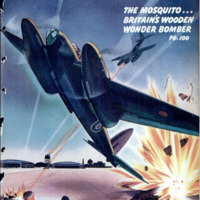 Popular Science Monthly, vol. 143, n. 6, 1943
Popular Science Monthly, vol. 143, n. 6, 1943


